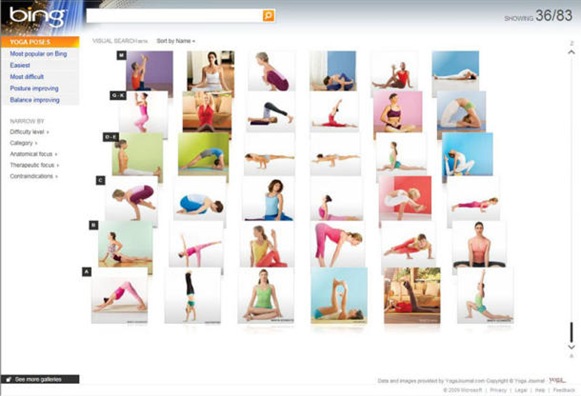You see that headline? "Visual Search" is in quotation marks because Monday's announcement at the TechCrunch 50 conference about Bing's new search feature is a bit of a canard.
What Microsoft is launching is very cool, mind you. It's just not, strictly speaking, a search feature. At least not a general one.
The new feature shows you pretty Silverlight-powered fly-in thumbnail images for only 50 specific search results (it will be expanded in the future), such as "Digital cameras," "New cars," "MLB players," and "Top songs." As you refine a query from one of the 50 visual searches available, thumbnails that don't match your query anymore fly off screen, and the rest reshuffle to fill in the blank spaces.
the feature looks fantastic, and search results link to other nicely functioning Bing search results pages and widgets, like shopping pages and sports player stats boxes.

Bing Visual Search loads up a page with visual thumbnails of what you're looking for. This example shows yoga poses.
(Credit: Microsoft )
The Visual Search feature showcases the real value of having a search engine that blends structured data into its results. Google has structured data, too. (Try searching for the title of a movie that's currently playing in theaters). But Bing pushes it further. In travel, sports, and product reviews, for example, Bing is extremely aggressive in displaying structured data. Bing also has Powerset technology (it acquired the company in 2008) for analyzing Wikipedia content.
But as with Wolfram Alpha, Bing's visual and textual filters don't work for the offbeat and weird, for a query that's not phrased just right to be picked up by the structured query engine, or for what people might consider ordinary little searches. Type in a less mainstream query, and you're skimming a sea of indexed text from Web pages, not structured data. Bing is still a good general-purpose search engine, mind you, but it does not beat Google as the king of the long tail.
Still, it makes business sense to pour resources into popular searches. Optimizing for the short snout pays. That's the model that made About.com worth $410 million to The New York Times in 2005. And that's what entrepreneur and TechCrunch50 co-host Jason Calacanis is aiming for with his curated directory, Mahalo.
I'd wager that this is how Bing is making its gains in market share. Latest Nielsen data says Bing gained 22 percent month-over-month in August, taking it to 10.7 percent of all U.S. searches. People probably try Bing for a travel or product search (where there's also a cash-back financial kicker) and remember their good experience, and then they try it for more obscure searches and find it good enough. It highlights, I believe, an important flaw in Google's historic strategy of indexing the entire Web equally well and making the user interface fast and consistent above all, as opposed to specializing as dictated by the query.
source: news.cnet